Scaling an organization is one of the most challenging tasks every entrepreneur has to face. And as a marketer, I've seen how much of an impact marketing can have on that process.
For the Moosend family, it took 10 years of consistent planning and execution to become an industry leader and a popular email marketing tool among top-level marketers. Here's how our marketing helped us get there.
The marketing strategy that got us where we are today
"The marketing tech industry has gone through several evolutional stages over the past 10 years. And Moosend helped re-defined the email marketing and marketing automation space. Our ambition has always been to help small companies to get the most out of their marketing campaigns. Fast forward to today, Moosend is a top email marketing tool with thousands of happy customers and raving reviews." – Yannis Psarras, co-founder of Moosend
Starting a business is one thing, but scaling it is a whole different story. For Moosend, the marketing team was a core element that helped us get where we are today (having been acquired by Sitecore in 2021). With the right people, tools, and partnerships, we were able to excel and shape the brand's identity as we know it today.
The marketing team's goal is to increase registrations: acquiring qualified leads is crucial for the company's success, but taking that extra step and leading them toward the registration process is even better. With that goal in mind, Moosend's marketing strategy consists of two main pillars:
Content creation
Content distribution
Combined with complementary tactics, our content has gotten us where we are today. Let's take a look.

The art (and science) of content creation
Moosend spends a lot of time and resources creating the best possible content for our audience. Crafting high-quality content, though, is challenging, and to succeed in this long-term game, we followed a specific process.
1. Content gap analysis
We do our keyword research primarily through content gap analysis, a method for examining the content of a website to discover hidden and missed opportunities. It's a great way to both optimize current content and generate new material.
Using content gap analysis can help an organization:
Find the keywords that their competitors rank for but they don't (keyword research)
Fill content gaps in existing content (content optimization)
Create new posts (content creation)
We use Ahrefs, which has a dedicated feature for content gap analysis, helping us find keywords our competitors are ranking for but we aren't.
To get started, enter your domain in the search bar, and then hit enter.

Then head over to Content gap.
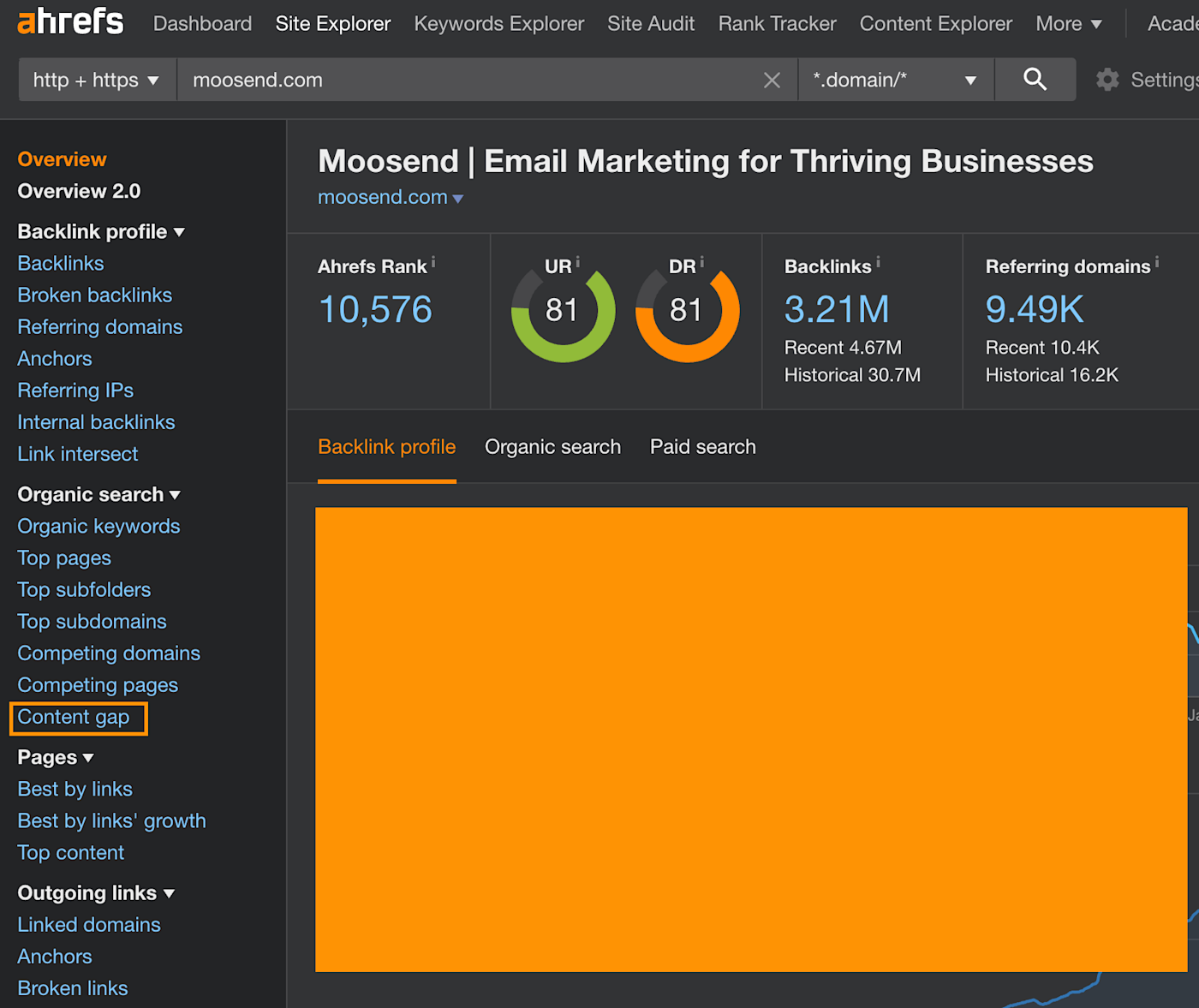
You can then add your competitors' URLs and then your URL. Click Show keywords.

You'll get a list of potential keywords that will bring you closer to the success of your competitors. But you'll need to curate that list to ensure that you choose the best keywords for your type of content. For example, at Moosend, we don't want to rank for "mailchimp login," but we do want to rank for "digital marketing."

2. Keyword opposition to benefit (KOB)
A KOB score is what you get when you sort keywords based on data you've gathered from your keyword analysis and then use that data to prioritize your content and rank faster. Here's a simple formula of how it works.
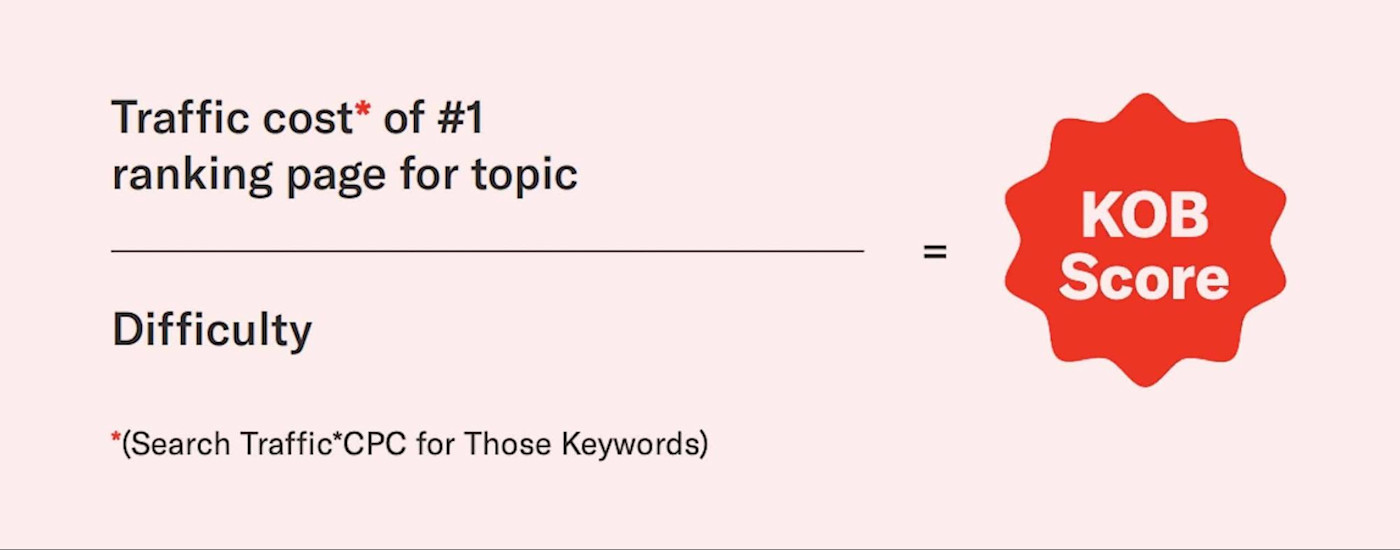
Here are the most important KOB score elements:
Volume: The average monthly searches for a specific keyword
Ahrefs difficulty: An estimation of how hard it is to rank for a term in the top10
Page traffic value: Page traffic multiplied by the CPC of the keyword
Priority average: An estimate of how important it is to write this article
Here's what it looks like when we compile all the keywords from our research with data provided by Ahrefs, including the priority, difficulty, and KOB average.
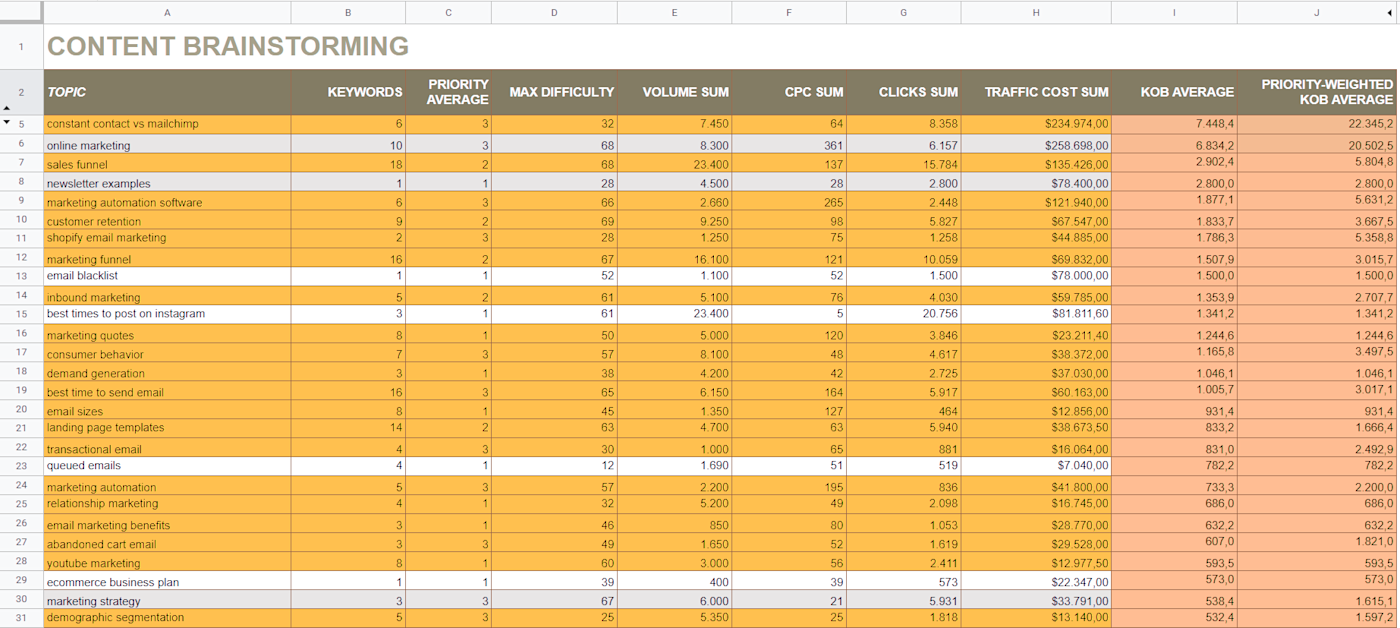
The revised KOB score is the true opportunity of a keyword. It's not a totally objective metric, but it can help us prioritize our work and then proceed with our content creation. This whole process usually takes about 30 hours—and it's totally worth it.
Pro tip: Filter by values that are appropriate for your business. If you have a new website with low DR, you might want to drop the difficulty to less than 40 to be more realistic about the type of content you produce. On the other hand, an organization with high authority may increase it to 60-70. That's a starting point to further tweak your strategy based on results.
If you want to understand the full theory behind the KOB score, check out this informative video from SiegeMedia.
3. Search intent
Once we're ready to create content, we start by analyzing search intent—we want to understand the psychology behind every keyword. What does the searcher actually want in the results?
We enter a keyword into Ahrefs—in this case "how to start with email marketing campaigns"—and then count the words that reflect purpose.
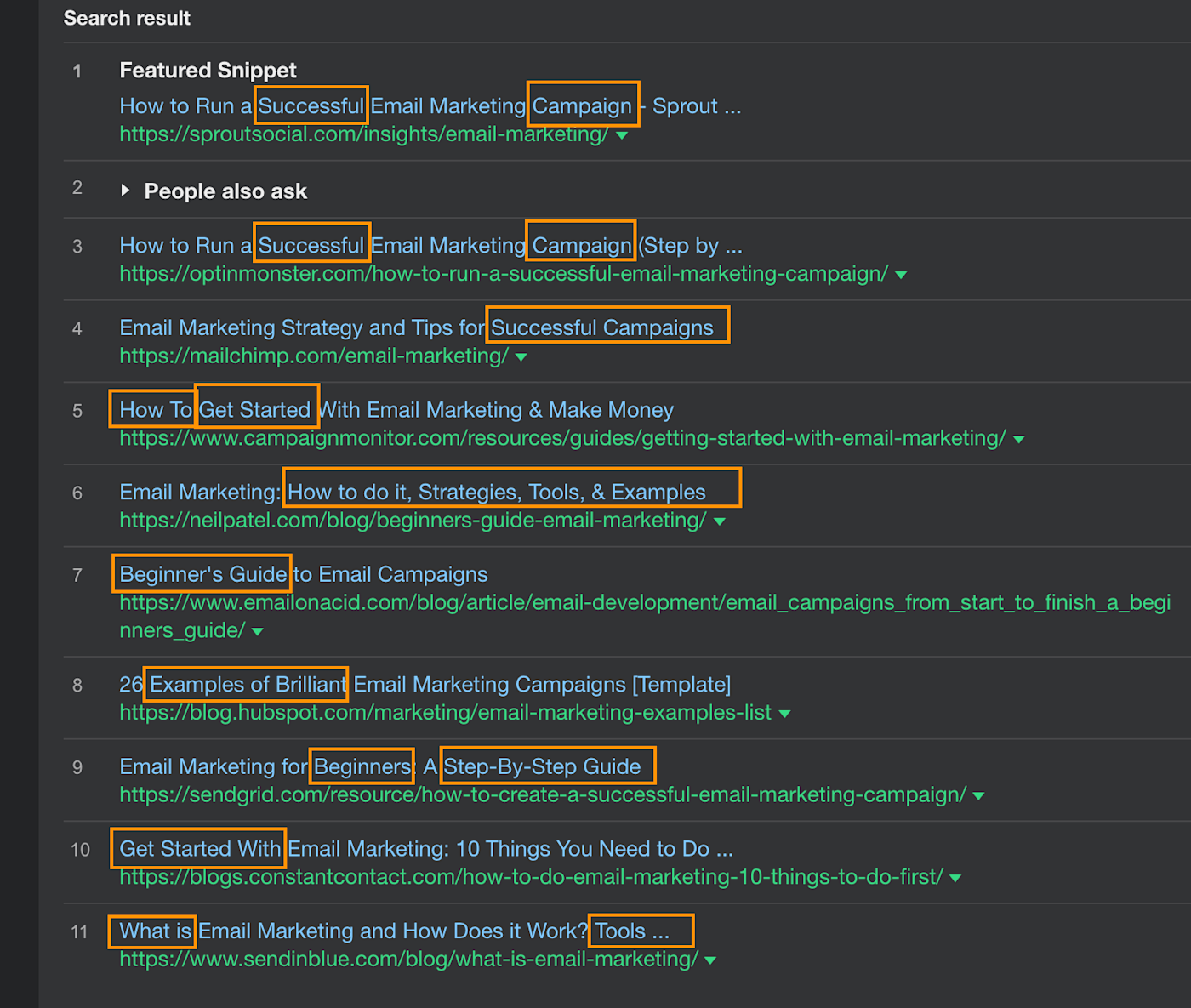
Of course, we can group some terms like "get started" and "beginners," so our final list might look like this:
(3) successful
(3) how to
(4) get started/beginners
(2) tools
(1) guide
This is what readers will want from our article—that's a good start. But we also want to know how other people are approaching this topic, so we head to Clearscope and run a report on a potential keyword.
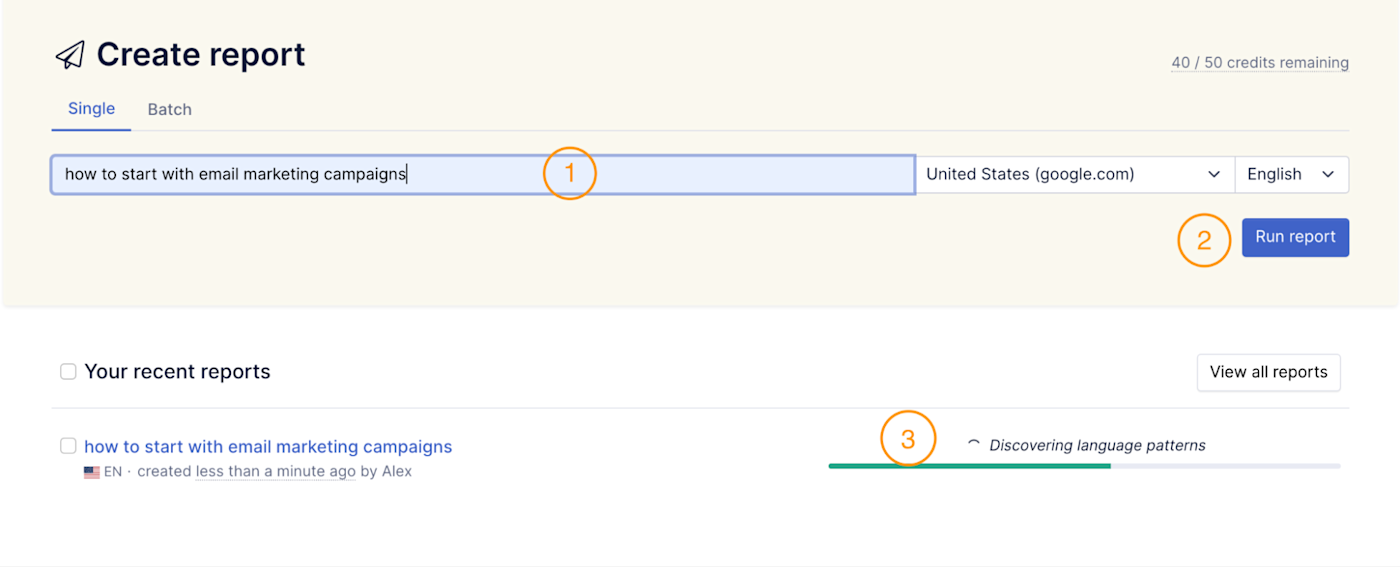
This gives us a list of competitor articles, content grades, and word count. Depending on your topic, you'll want to ensure you've got the best type of content to help you rank it faster, so don't forget to take a look at the Page Types section.

We primarily leverage two features: Keyword Discovery and Terms map.
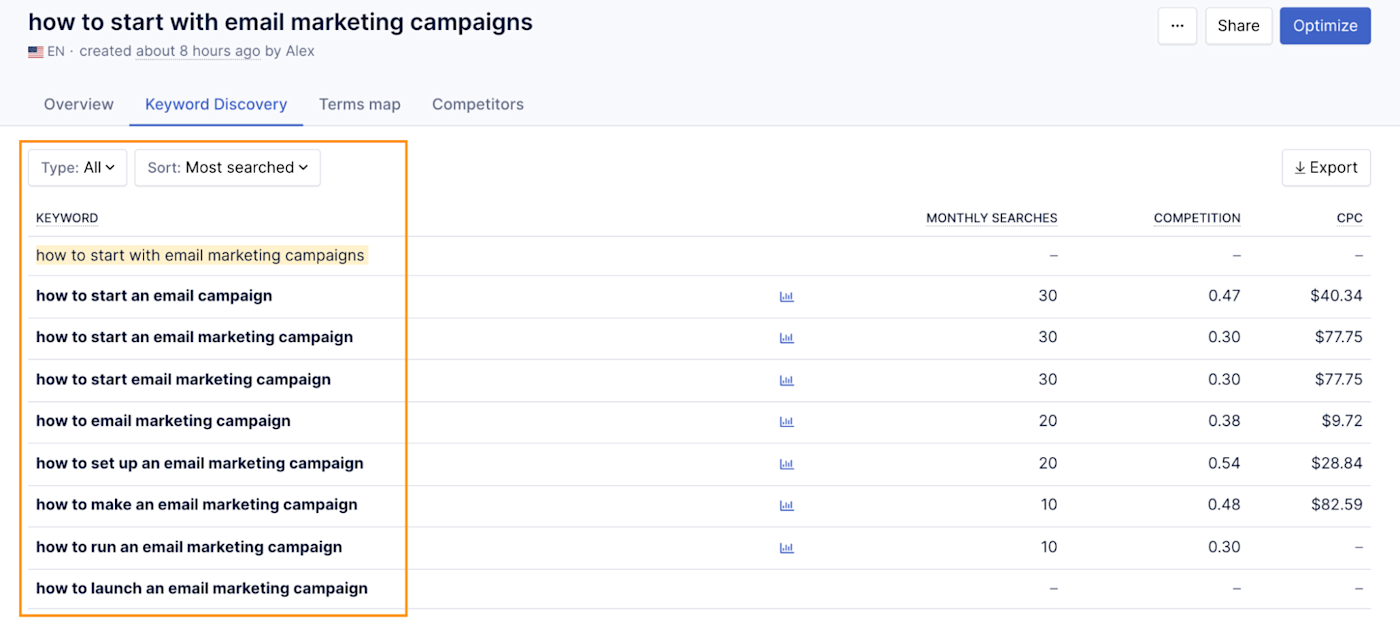
These two lists can provide us with thoughtful keywords to include in our outline. Sort the Terms map by Heading instead of Importance to increase your chances of creating solid headlines.
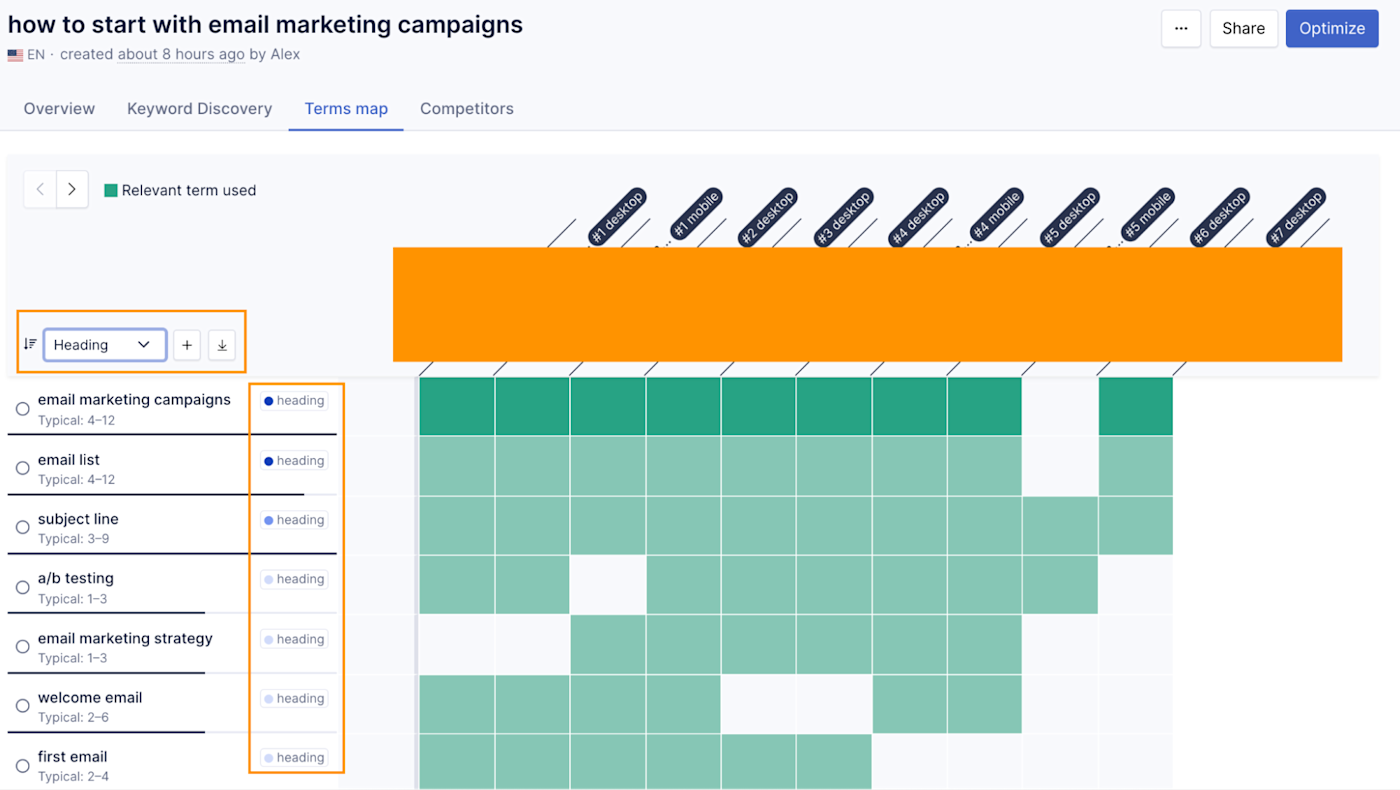
Remember that these are keywords that your competitors use in their content.
4. Unicorn blog post
Back in 2018, most email marketing services used landing pages to compare the various services in our niche. It was a no-brainer for Moosend to create similar benchmark landing pages to compare the different ESPs. Here's what we used to have.
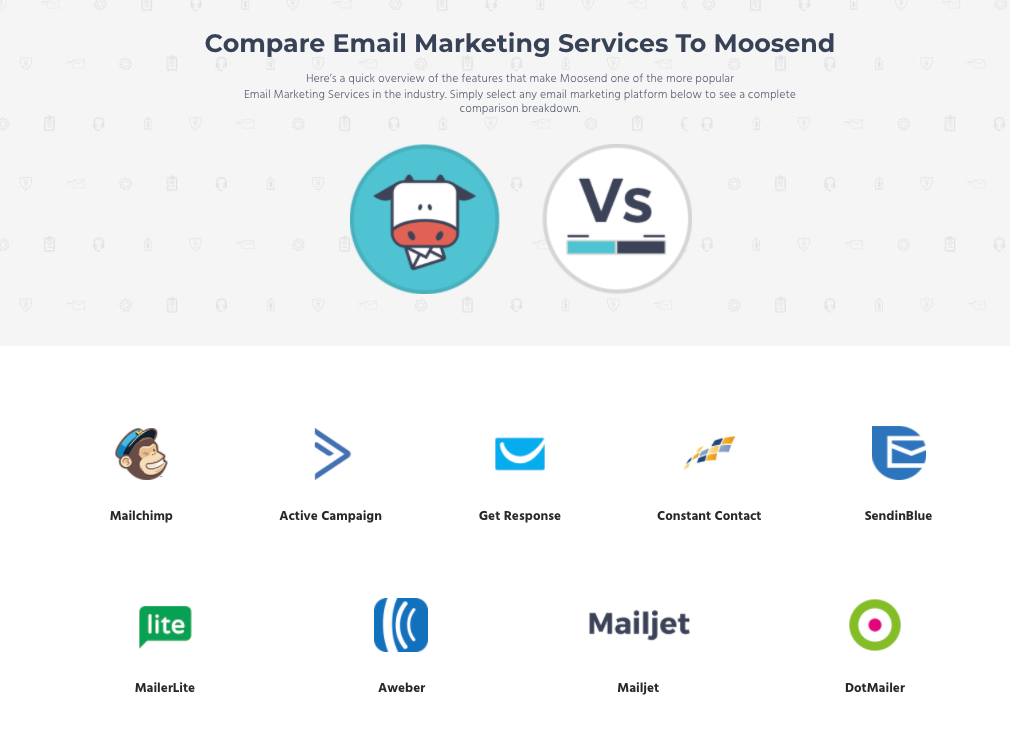
After investing loads of resources and time trying to rank this page, we realized that the content wasn't valuable enough to win a position in Google's rankings. That's where the team started thinking differently than our competitors.
The new concept was to create an educational and informative article that would attract a lot of traffic while also converting readers searching for a new email marketing service. And that's how we landed on 9 Best Mailchimp Alternatives for 2022 [Free and Paid]. The article had the same characteristics as the landing pages of our competitors, but it was more helpful, so it could rank better.
We used the methodology described above to find the right keywords and the intent behind them. That gave us a solid structure that helped us create an optimized article. This piece of content is one of the most successful articles we've ever written, the unicorn of high traffic and high conversion rates.
And it happened because we did that content gap analysis, KOB analysis, and search intent classification.
Take a look at that conversion rate:

Content distribution
"Looking back and analyzing every step of our journey, I could never imagine that a small group of 5 people could build over 2,600 mentions for Moosend." - George Fakorellis, Head of Organic Acquisition
Of course, you can't stop at creating your content, so we also make sure to invest in content distribution. Here's a brief look at what we do:
Guest posting. Guest posts (like this one!) have helped us rank better with Google and build relationships with other organizations in our niche. We make sure to focus on sites with high user engagement and domain authority. Here are some other tips for how to submit a guest post.
Partnerships. Every team has a ceiling, but small teams will need to get really creative in expanding their reach. Moosend started leveraging partnerships in 2018. We focus on quality over quantity, and it's helped us get valuable mentions from high-quality websites.
Complementary marketing strategies
"Leveraging resources and know-how from the content and distribution channels, we were able to build two additional teams that intersect with each channel from the ground up. This allowed us to break down the silo mentality and create a unified front whilst working towards the same goal." – Nick Dimitriou, Head of Growth at Moosend
Content is at the core of Moosend's marketing, but we also use three other channels to complement this process.
1. Affiliate marketing
Affiliate marketing is a tactic in which an organization pays third-party people to drive traffic or leads to its products and services. In a nutshell, it's a pay-for-performance marketing strategy. Moosend's affiliate program has created new traffic sources and leads and has also helped us boost brand awareness.

Affiliate marketing is resource-intensive. You'll need a dedicated team that helps ambassadors create more impact for your brand. As part of this process, Moosend built an affiliate resource center containing branded elements that affiliates can use.
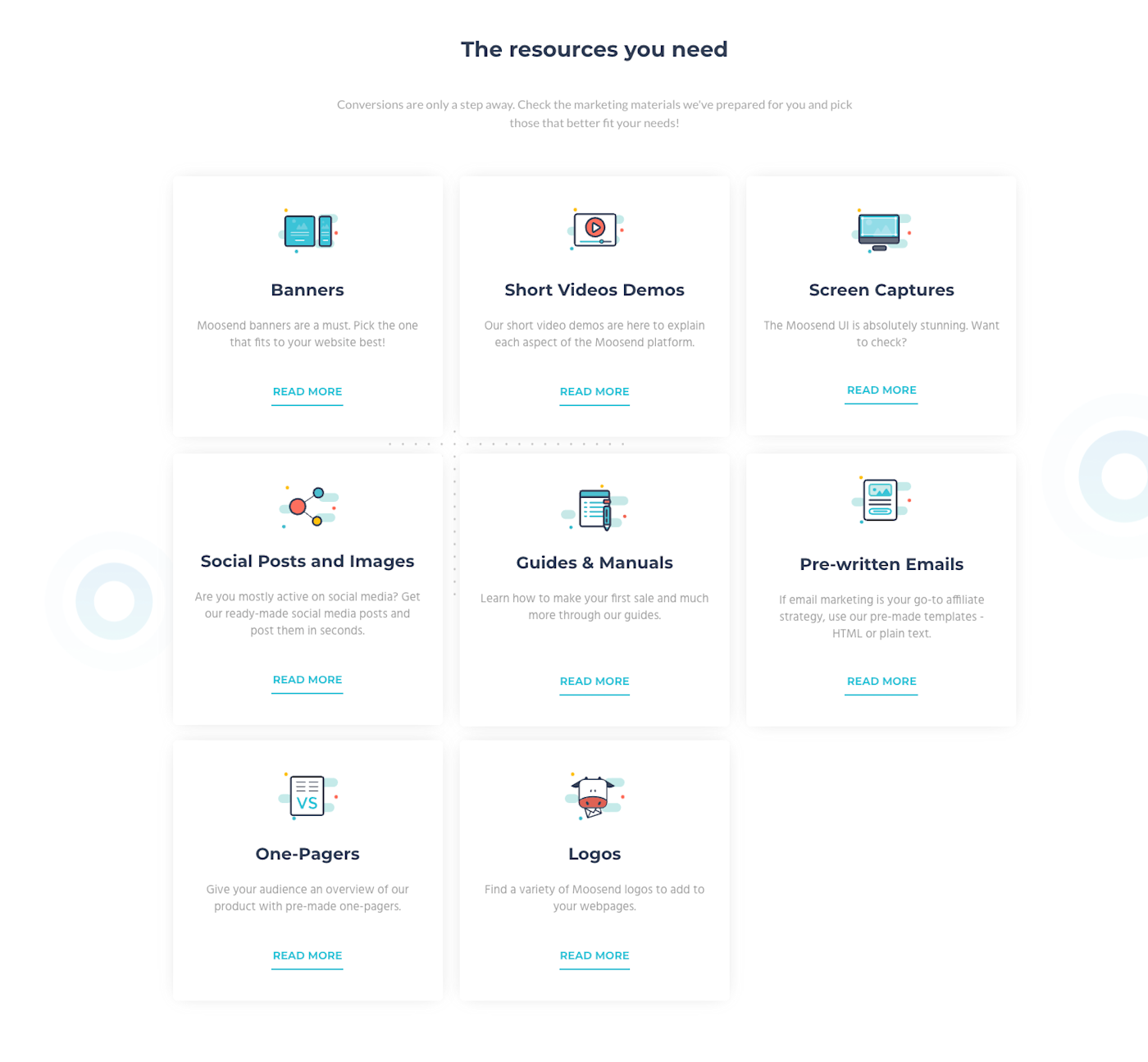
We also created resources to educate affiliates on Moosend's product.
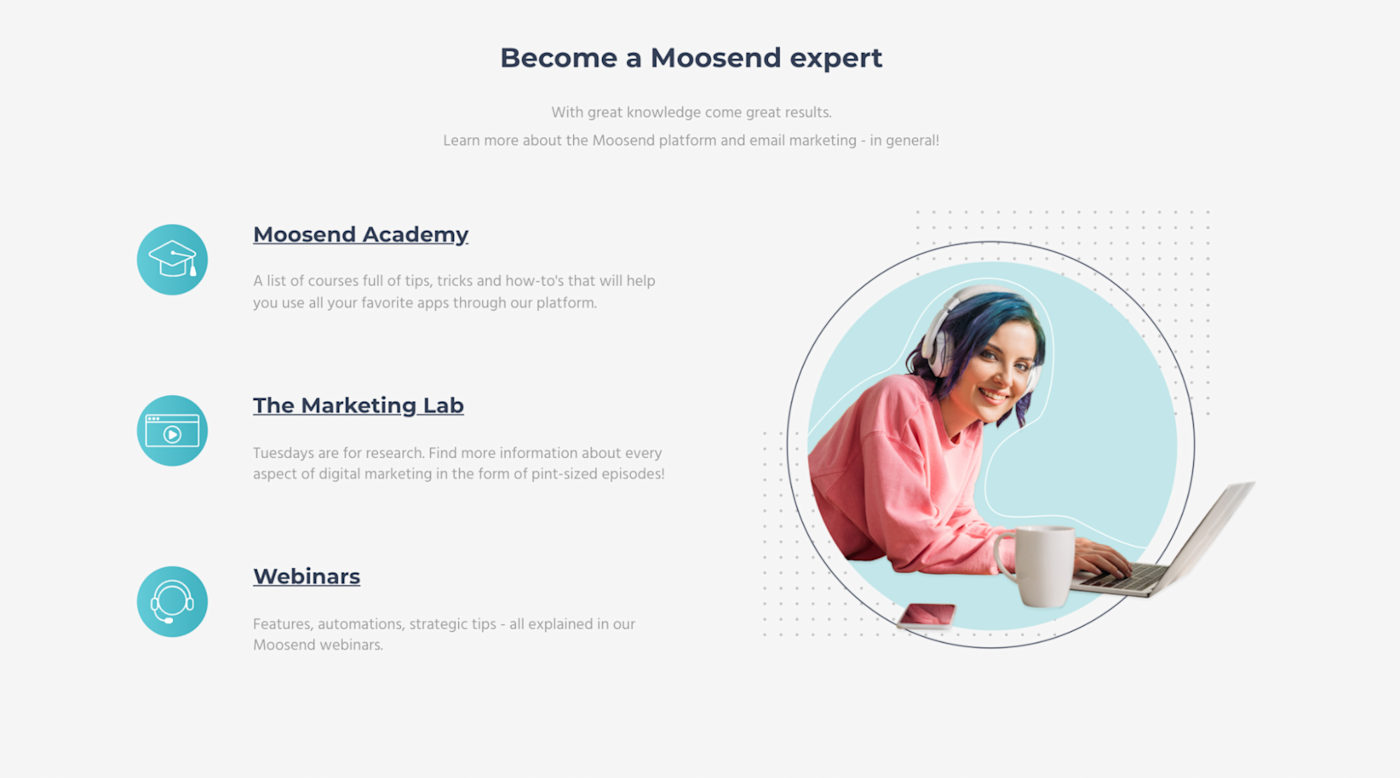
It took a lot of time, but it's been crucial for running our affiliate program. And the ROI shows that it's been well worth it. Take a look at the registrations that are directly related to the affiliate marketing program:

As you can see, affiliates are a huge part of Moosend's success as they bring new traffic for the website and targeted leads that convert into registrations. But what happens when these leads don't convert? We don't want to lose the work the affiliates put in, so in this case, we try to re-engage them with retargeting ads.
2. Retargeting
Users who visit a website but don't complete the desired action—purchase a product, signup for a newsletter, download content, upgrade, etc.—can receive personalized ads through retargeting.
It allows us to display highly targeted ads based on the page or product that the user was checking out. As an example, check out that display ad that retargets folks who were looking at our "Mailchimp alternatives" article that I mentioned above.
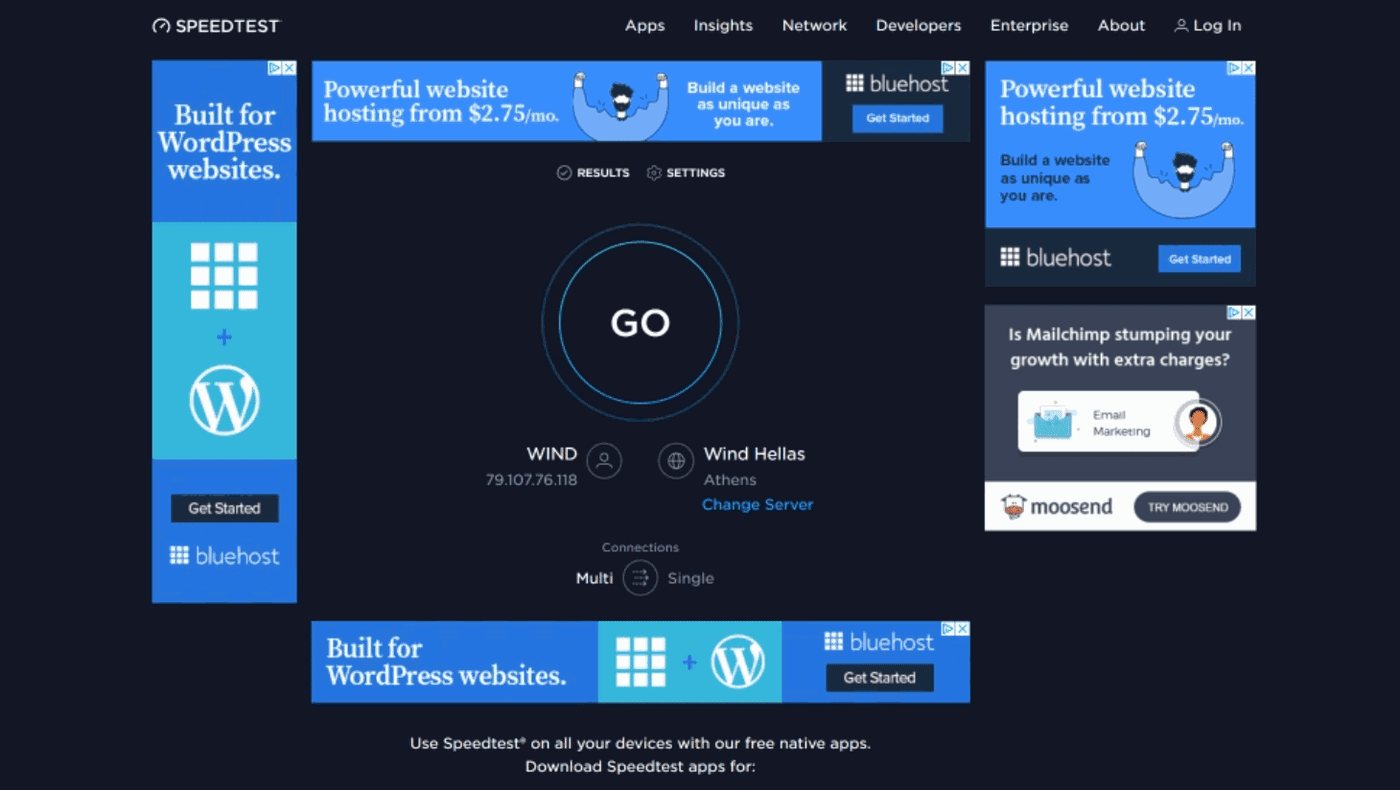
People reading that article were likely looking to change their email marketing software. Investing in retargeting ads to help these people take action is a no-brainer to increase our registrations.
3. CRO
Moosend has a more user-centric approach to conversion rate optimization (CRO). When we try to improve our conversion rates, we focus on understanding what motivates and eventually persuades visitors to take action to provide them with the best possible user experience.
At Moosend, we follow all CRO best practices, but we also invest time in getting to know our users to establish a customer-centric culture. We focus on existing pain points and feedback from our audience to discover as much as we can about their needs—and then provide solutions to address them.
We also have an amazing tech stack that helps us with our CRO:
Analytics tools for tracking website traffic in general (Google Analytics)
Heatmaps for websites that aggregate the number of clicks, scrolling, and movement on a page (Hotjar)
Form embeds that add value for our readers (e.g., more content) while still helping us reach conversion goals
A/B testing software that allows us to compare different versions of a page (Google Optimize)
Conversion-tracking analytics tools (Google Analytics)
Moosend uses these tools in different ways depending on the goal of each page and the experience we want to create for our users. Success begins when the tools that convert traffic into data help us understand:
What our website's visitors have to say about it
How users interact with our website
The characteristics of the people in our market
Connections between content and conversions
The takeaway
All this is the outcome of a 10-year journey as a business and three years of practical marketing implementation. I'd encourage you to take inspiration from Moosend's success—which ended up with an increase in registrations by 729.27% in three years.

But keep in mind that it takes time. Focus on producing high-quality content that gives value to your audience, distribute your content through various channels, and then add new strategies to work in tandem with your content.
Remember that every business is different, and to excel in your niche, you need to adapt and make data-driven decisions. I hope this article will help you create the next Moosend.
This was a guest post by Alex Souchoroukof, a writer for Moosend, a leading email marketing tool. Want to see your work on the Zapier blog? Read our guidelines, and get in touch.





